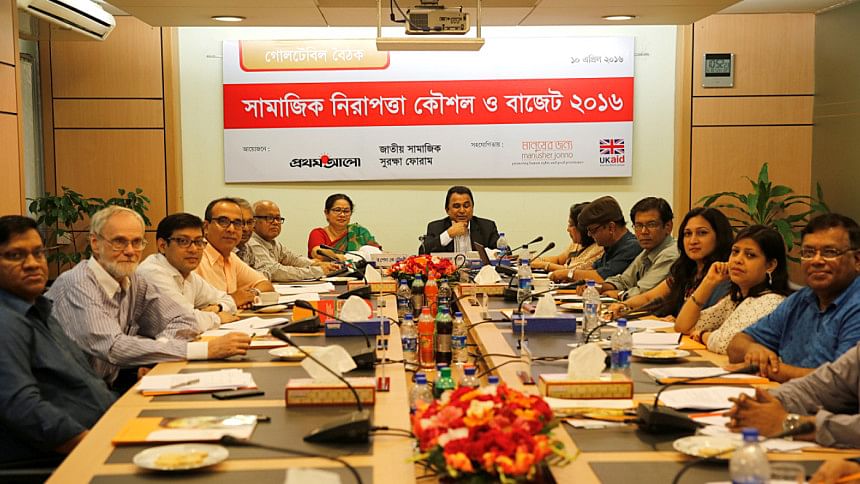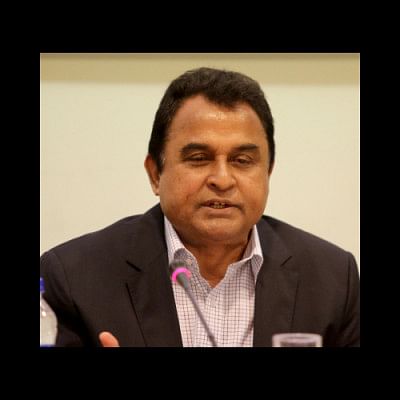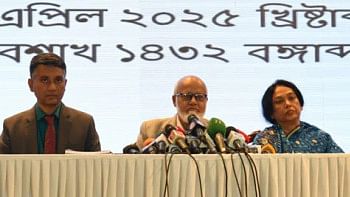Social Protection Strategy and Budget 2016


Abdul Quayum, Associate Editor, Prothom Alo & Moderator of the Session
Today, we will discuss on the social protection strategy and the budgetary allocation for this sector. There are many social protection programmes in the country. We can make these interventions more effective by ensuring proper monitoring and coordination. It will reduce overlapping and leakage problem.
Our budgetary allocation for social protection programmes is not adequate. The government needs to increase it. At the same time, we have to ensure that the allocated fund reach the beneficiaries in a transparent and regular manner.

Rasheda K Choudhury, Director of Campaign for Popular Education and convener of NFSP
We can increase allocation for social safety nets by reducing corruption and violence against women. Corruption eats up 2 percent of GDP and violence against women also costs a similar percentage of GDP. The government should also not increase the allocation for unproductive sectors.
From today's progamme we want to urge the honourable Planning Minister to introduce mid-day meals in schools, as it helps improve the quality of education. It will be very beneficial. It should be seen as an investment and we will get a return in future.
We should expand our indicators of poverty. We always emphasise on income poverty. There are some areas, for example Sylhet, where the income level is high but all the social indictors are low. In our social protection programmes we should focus on these social indicators of poverty.

Shaheen Anam, Executive Director, Manusher Jonno Foundation
The government has allocated 2.19 percent of the GDP for social protection. We have to ensure that the poor people get maximum benefit from this fund. DFID along with some other partners such as UNDP, Australian Aid, WFP have signed a MoU with the government in this regard. Manusher Jonno Foundation has been entrusted with two particular responsibilities. It will do policy advocacy following the feedbacks from the poor people on the social protection programmes. We have established National Forum for Social Protection. There are two sides of the social protection programmes. One is to support people who need it for whole life such as elderly persons. Another is time bound. These people need support for a particular time to graduate from extreme poverty. We are also trying to prepare an effective grievance mechanism to address various weaknesses of the social protection programmes.

M M Akash, Professor, Department of Economics, Dhaka University
Currently, at least four crore people live below the poverty line in Bangladesh. But the number may go up to 8-11 crore if $2 a day is taken as the poverty line.
First, I will highlight the challenges of the social protection strategy. In Bangladesh around 85 percent employment happens in informal sectors where there is no provision of pension and job security. The government provides some funds to the poor people through various allowance mechanism. But these are inadequate in terms of both number of recipients and amount of the money. We need to spread the coverage of the protection scheme as well increase the allowance amount. That's why the government needs allocate more funds in the budget for this sector.
The government carries out its social protection programmes predominantly in rural areas. The problem of urban poor gets little attention. They suffer from high rent, sudden hike in prices of necessary goods, lack of urban amenities, insecurity and so on. We need to think about introducing ration system for these poor people.
Twenty three ministries operate 145 social protection programmes in the country. There are issues of overlapping, corruption, lack of coordination that need to be addressed seriously to get the best result of these programmes. There is a reform proposal in the strategy paper that can be a starting point.
Between 25 percent and 50 percent of the state support does not reach the real recipients because of corruption, wrong targeting and leakage. As the complaint system is very weak we do not get real feedback from the grassroots.
The government allocated Tk 16,000 crore in fiscal 2009-10 and Tk 37,000 crore in fiscal 2015-16 for social safety nets. The daily average per capita allocation stood at Tk 5 for the 8.52 crore recipients in fiscal year 2009-10 and at Tk 7 for 9.08 crore recipients in fiscal year 2012-13.
The expenditure of middle-income nations for social safety nets falls between 6 percent and 8 percent of their gross domestic product. On the other hand, the allocation is equivalent to 2.19 percent of GDP in Bangladesh. The policy-makers want to keep the rate unchanged until 2020, which is the most worrying part. The expenditure is inadequate from the macro point of view. The allocation must be increased to make it meaningful.

Faizul Islam, Deputy Chief, Planning Commission
I want to emphasise on informal sector. In this sector there is no contract mechanism between employee and employers. We need to think how we can include these people in the social protection programmes.

Tofail Ahmed, Director, MJF and Co-convener of NFSP
There is a difference between poverty reduction and providing social protection. We should not confuse one with the other. Social protection works in life-cycle approach that provides a person life-long support.
Taxpayers currently do not see any benefit from paying taxes because they take various services such as healthcare from the private sector. The government should link tax payment with a universal pension scheme to encourage people in paying tax. It can transfer a portion of the tax to the pension scheme for taxpayers.
Local government bodies need to be involved more in the social protection programmes. In Kerala, village Panchayats carry out these programmes. It ensures proper delivery and monitoring of social protection funds.
There is an information centre in each Union Parishad. They can collect and update social protection programmes related information on a regular basis. It will help create an authentic national database.

Towfiqul Islam Khan, Research Fellow, Centre for Policy Dialogue
There is no doubt that the allocation for social safety nets is scanty. Some 27 percent of the allocation under social safety net schemes goes for pension for government employees, meaning the true allocation for the poor is actually less. The government employees' pension scheme should not be counted as part of the social safety net.
There are discrepancies between the goals laid out in the planning ministry's national social protection strategy or NSPS and the finance ministry's medium-term budgetary targets. For example, the NSPS aims to bring 55 lakh senior citizens under the elderly allowance scheme by 2018, whereas the finance ministry puts the number at 30 lakh in its medium-term budgetary targets. A similar difference is also seen in budgetary allocation and allowance. This indicates a lack of coordination between finance and planning ministries.
I appreciate the government's efforts to prepare a poverty database. If we get the list of beneficiaries of all the social protection programmes and make the information public it will help curb leakage.

Md. Shafiqul Islam, Country Director, ADD International Bangladesh
In Bangladesh we have no reliable database of poor people. That's why efficient targeting is quite difficult here. I would request the planning ministry to take an initiative in this regards.
In many cases people with disability cannot go the government offices due to mobility problem. Here the government should reach them. Again, political consideration determines selection and allowance under the social safety nets. People with disability often become victim of such malpractices.

Benedict Alo D' Rozario, Executive Director, Caritas Bangladesh
Our social protection programmes should follow rights-based approach. The beneficiary selection process should be made participatory at the grassroots level. In Caritas, we practice a participatory selection system where the people identify the recipients and finalise the list.
Our accountability system should be extended upto the grassroots level. That's why there should be some allocation for independent monitoring in the budget. After completion of a project we can assess the outcome in a participatory mechanism. Finally, we should allocate funds for the poor people in hilly areas under the safety net scheme.

Naved Chowdhury, Poverty and Social Protection Adviser, DFID Bangladesh
Our country is on the way to becoming a middle-income country. We should also aspire for a change in budgetary allocation and for increased allocation for social safety nets. The total allocation for social protection should be raised gradually from 2.2 percent of GDP to 4 percent and later to 6 percent.
I would request our Planning Minister to play a coordinating role in bringing the 145 social protection programmes into the seven clusters defined by NSS. It will certainly bring a positive change in executing these programmes. We also need an effective coordination between finance ministry and planning ministry.

Shashwatee Biplob, Senior Program Manager (Development Cooperation), Australian High Commission
We already have plan and strategy paper for social protection sector. Now we need to prepare an action plan.
Along with providing social security we need to impart skills to the impoverished people. Otherwise they will not be able to come out of the poverty trap.

Palash Kanti Das, Assistant Country Director, Head, Poverty Reduction Cluster, UNDP Bangladesh
In assessing impact of social protection programmes we need to emphasise on two important factors: addressing emerging risks caused by natural disasters and urban poverty reduction. We often miss these two issues that have considerable impact on our poverty situation.
There should be a synergy between the reforms initiatives of administration and programmes of the social protection sector. We need to develop a national methodology for targeting.

Goran Jonsson, Senior Programme Adviser, UNDP Bangladesh
In Bangladesh there is still a poverty gap because of wrong targeting. Many people who do not need support are getting fund while a significant number of vulnerable people are left out of the protection programmes. This discrepancy exacerbates the poverty gap. Another related issue is finding out who needs what amount of support. We need to maintain that the lowest quintile of poor people get the highest amount of support.
It is very important that you have to have enough allocation. Allocation in social protection is an investment. It should not be seen as a cost. Through social protection programmes we bring poor people into the mainstream so that they can contribute to our GDP.

S M A Rashid, ED, NGO Forum for Public Health and member of NFSP
We need to distribute our social protection programmes according to our regional variation of impoverishment. We should not left behind the poverty pockets.

Arefin Akhter, Senior Programme Officer, WFP
Timely disbursement of fund is very important. We have to ensure that the poor get the help when they need it most.
Another important issue is proper use of the fund. Sometimes we see that the fund provided for lactating mothers or pregnant women is being used for other family purposes. That's why we need a consultation and awareness building mechanism in our programmes.
In our social protection programmes the nutrition issue does not get much importance. I would request the planners to emphasise more on nutrition-related intervention.

AHM Mustafa Kamal, Minister, Ministry of Planning
I do not agree that there is widespread wrong targeting of beneficiaries under the safety net schemes. We have improved our monitoring system a lot. People are also more conscious today. They protest against any kind of discrepancy.
It would not be possible to register development in a real sense if anyone remains excluded. Economic progress here means progress of all. We will bring them in such a position that they do not look behind.
Our tax to GDP ratio is very low. We can do more for the poor if we can raise the revenue collection. We also need more concerted efforts from all stakeholders to stop leakage and improve coordination.
The government has taken 20 projects to reduce poverty and increase the capacity of the poor. The planning ministry wants to take social protection projects in Haor and Char areas. I would request you to come up with effective project proposals to reduce poverty in these pockets. I do not think fund is a major constraint. We need better ideas. The government will allocate fund for implementing these ideas.

 For all latest news, follow The Daily Star's Google News channel.
For all latest news, follow The Daily Star's Google News channel. 



Comments